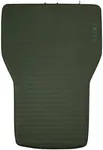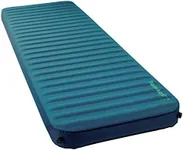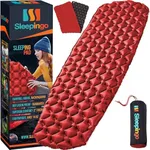Buying Guide for the Best Camping Sleeping Pads
Choosing the right camping sleeping pad can make a huge difference in how well you sleep outdoors. A good pad provides comfort, insulation from the cold ground, and can even help reduce aches and pains after a long day of hiking. When picking a sleeping pad, think about where and when you'll be camping, how you'll carry it, and what kind of sleeper you are. Understanding the key features will help you find a pad that matches your needs and ensures a restful night under the stars.Type (Foam, Self-Inflating, Air Pad)The type of sleeping pad refers to how it is constructed and how it provides cushioning and insulation. Foam pads are simple, durable, and lightweight, making them great for rough use and easy packing, but they can be less comfortable. Self-inflating pads combine foam and air, offering a balance of comfort, insulation, and convenience, but they can be heavier and bulkier. Air pads are the most compact and lightweight when packed, and can be very comfortable, but they require inflation and can be more prone to punctures. Your choice should depend on your priorities: if you want simplicity and durability, go for foam; if you want comfort and don’t mind a bit more weight, self-inflating is a good choice; if you need to save space and weight, air pads are best, but be prepared to inflate them and handle them with care.
R-Value (Insulation)R-Value measures how well a sleeping pad insulates you from the cold ground. The higher the R-Value, the warmer the pad will keep you. R-Values typically range from about 1 (minimal insulation, good for warm weather) to 7 or more (excellent insulation, suitable for winter camping). If you camp mostly in summer, a low R-Value is fine. For spring and fall, look for a moderate R-Value (around 3-4). For winter or cold conditions, choose a pad with a high R-Value (5 or above). Think about the coldest conditions you’ll face and pick a pad that matches those needs.
ThicknessThickness refers to how much padding the sleeping pad provides between you and the ground. Thicker pads (2 inches or more) offer more comfort, especially for side sleepers or those who want extra cushioning. Thinner pads are lighter and pack smaller, but may not be as comfortable, especially on rough or uneven ground. If you value comfort and don’t mind a bit more weight or bulk, go for a thicker pad. If you’re trying to keep your gear as light and compact as possible, a thinner pad may be enough, especially if you’re used to sleeping on firm surfaces.
WeightWeight is important if you’ll be carrying your sleeping pad in a backpack. Lighter pads are easier to carry, but may sacrifice some comfort or durability. Heavier pads often provide more cushioning and insulation, but can be a burden on long hikes. If you’re backpacking or hiking long distances, look for a lightweight pad that still meets your comfort and insulation needs. If you’re car camping or don’t have to carry your gear far, weight is less of a concern and you can choose a pad based on comfort.
Packed SizePacked size is how small the pad becomes when rolled or folded for transport. Smaller packed sizes are easier to fit in a backpack or with other gear. Foam pads are usually bulkier, while air pads and some self-inflating pads can pack down very small. If space is tight or you’re backpacking, look for a pad with a small packed size. If you have plenty of room, such as when car camping, packed size is less important.
DurabilityDurability refers to how well the pad stands up to rough use, punctures, and general wear and tear. Foam pads are usually the most durable, while air pads can be more delicate and require careful handling to avoid punctures. If you camp in rocky or rough areas, or want a pad that will last for years, prioritize durability. If you’re careful with your gear and want to save weight, you might be comfortable with a less durable but lighter pad.




















